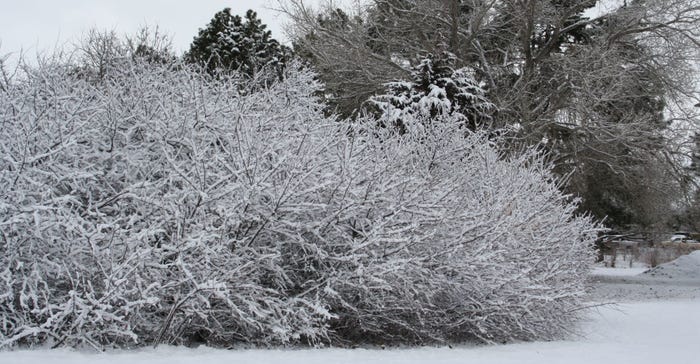December 30, 2021

What types of shrubs can I plant around the farmstead that will be most drought-tolerant? Most shrubs are generally drought-tolerant to some extent. However, there are several Great Plains natives that take drought tolerance to a whole new level. These are species that, once established, can generally be relied on to survive without supplemental water, except in the worst of drought situations.
Another good reason to plant native shrubs is that they’re some of the most helpful plants for sustaining pollinators, beneficial insects, birds and other wildlife. Finally, many of our native plants are not only palatable to wildlife, but also offer tasty fruits for us to eat.
Here are several species to consider planting in your landscape. Please note the geographic limitations for some of them:
American Plum. Prunus americana is a common thicket-forming plant found throughout the Great Plains that will grow 6 to 10 feet tall. Give it lots of room to spread. Its flowers offer a sweet spring fragrance, and the fruits are great for jams and jellies.
Blackhaw viburnum. Viburnum prunifolium grows up to 15 feet tall and wide, becoming a graceful small tree with age. It provides beautiful spring flowers and fall color. It is best in the eastern Great Plains.
Buffaloberry. Shepherdia argentea is a tough western native that grows 8 to 12 feet tall and nearly as wide. Its silver foliage helps conserve moisture, and its bright red berries are edible.
Chokecherry. Prunus virginiana is another suckering shrub that can grow into a small tree in time. The fruits are fantastic for jams and wine, and the plant typically ends the year with orange fall color.
Common juniper. Juniperus communis is a northern Plains and Rocky Mountain species that combines well with Ponderosa pine. It grows 3 to 4 feet tall and 5 to 6 feet wide.
Currants. Ribes species, including clove currant and red currant, are common across the region and are very drought-tolerant. Clove currant is named for its spicey fragrant flowers. Currant fruits are tasty for both humans and wildlife, and plants typically grow 3 to 5 feet tall and wide.
Fragrant Sumac. Rhus aromatica and its cousin the skunkbush sumac (Rhus trilobata) are terrific natives that grow 4 to 6 feet tall and wide and are very drought-tolerant. Both species turn red in the fall.
Leadplant. Amorpha canescens is a semi-woody prairie plant and is often planted with native grasses. Its silvery foliage and blue-lavender flower spikes help it stand out in midsummer.
New Mexico locust. Robinia neomexicana is a tough-as-nails suckering shrub native to the Rocky Mountains that can grow up to 10 feet tall before dying back and resprouting. It’s a thorny plant with attractive and fragrant pea-like flowers. Give it room to spread and do its thing.
Rabbitbrush. Ericameria nauseosus is a western Great Plains native with silvery foliage and bright yellow flowers that bloom from late summer to frost, and attract a wide variety of butterflies and other pollinators. Rabbitbrush will grow 3 to 4 feet tall and wide, and it thrives on neglect. In fact, it will decline if overwatered. Limit its use to the western Plains.
Shrub oaks, including dwarf chinkapin oak. Quercus prinoides, which is native to southeast Nebraska, grows among mixed-grass prairie on rocky soils. It will eventually grow into a small tree, 10 to 15 feet tall and 10 to 15 feet wide, and will sucker moderately. In the western Great Plains, the better shrub oak is gambel oak (Quercus gambelii), which is native to the Rocky Mountains.
Snowberry and coralberry. Symphoricarpos spp. are low-growing, suckering shrubs that are best known for their colorful winter berries: white on snowberry and red or pink on coralberry. They brighten the winter landscape and provide important winter food for various birds.
Western sandcherry. Prunus pumila var besseyi is a sprawling plant that grows 2 to 3 feet tall and twice as wide. It’s relatively short-lived, but it has some of the best-eating cherries you’ll find.
There are several well-behaved non-native shrubs that are also quite drought-tolerant and worthy of planting on the farm. They include things such as Chinese juniper, mockorange, cotoneaster, privet and peashrubs (Caragana).
One of the best non-natives for drought tolerance and longevity is the common lilac (Syringa vulgaris). Many a farm is home to these fragrant shrubs that announce the arrival of spring with their sweet-smelling blooms. Lilacs have adorned the Evertson family farm in far western Nebraska for as long as anyone can remember, and they’ve survived some incredibly dry summers.
Evertson is assistant director at Nebraska Statewide Arboretum.
You May Also Like




